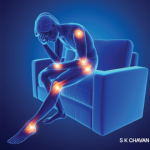Three investigators who made major advances in the understanding and treatment of rheumatic diseases were recently elected to the National Academy of Sciences (NAS). The NAS is an honorific society of scholars engaged in scientific and engineering research that was established in 1863. Daniel Kastner, MD, PhD, Ravinder Maini, MD, and Marc Feldmann, PhD, will join an elite group of scholars that includes Albert Einstein, Robert Oppenheimer, and Alexander Graham Bell. Seventy-two new members and 18 foreign associates from 14 countries were recognized for “their distinguished and continuing achievements in original research.”
Discovery of FMF Gene
Daniel Kastner, MD, PhD, is chief of the Laboratory of Clinical Investigation and clinical director of the Intramural Research Program at the National Institute of Arthritis and Musculoskeletal and Skin Diseases (NIAMS) in Bethesda, Md. He was elected a member of the NAS for his pioneering work in applying the tools of positional cloning to identify genes for rheumatic disease, most prominently familial Mediterranean fever (FMF), eventually leading to identification of a new class of rheumatic disorders. “My interest over the years has been in understanding the genes underlying hereditary diseases of inflammation, such as [FMF],” says Dr. Kastner. “This was early in the Human Genome Project, so it took several years of painstaking molecular detective work to finally identify the FMF gene on chromosome 16.”
Dr. Kastner’s group named the protein encoded by this gene pyrin. The N-terminal domain of pyrin is the prototype for a motif found in over 20 proteins involved in the regulation of inflammation. His group was the first to propose the term “autoinflammatory” as a unifying concept to describe illnesses characterized by excessive activity of the innate immune system. “We have been interested in various genetic disorders and were lucky enough to find some of the genes involved,” says Dr. Kastner. “That led to new understanding of the human biology of inflammation and genetic tests and brought about successful targeted therapies.”
Dr. Kastner views election to the NAS as recognition of not only his work, but also the work of those in his research groups and translational research work at NIAMS. Still an active clinician, Dr. Kastner was told of his election in an appropriate manner. “Notification came on a Tuesday, during my pediatric clinic,” he says. “I was talking to a patient and her parents when a knock came on the door and a colleague asked to see me outside. He told me I had just been selected for membership in the NAS. It was a moment of great exhilaration and delight followed by returning to my patients. Of course, they are what it’s all about.”
TNF Discovery Leads to Treatments
Two researchers at the Kennedy Institute of Rheumatology at the Imperial College London were also elected to the NAS. (Non-U.S. citizens who are elected to the academy are designated as foreign associates.) Sir Ravinder Nath Maini, MD, emeritus director, and Marc Feldmann, PhD, current director at the Kennedy Institute, were cited for their work identifying tumor necrosis factor a (TNFα) as a target in treating rheumatoid arthritis (RA), with their studies of infliximab inaugurating the era of biological therapy. Having both worked on lymphoid cell mediators in 1970s, Drs. Maini and Feldmann joined forces in 1985 and used modern molecular biology and immunology techniques to find which were the key molecules in perpetuating rheumatoid synovitis. In laboratory experiments from 1985 to 1992, Drs. Maini and Feldmann, along with their research teams, found compelling evidence that inflammation and tissue damage in RA was driven by activation of multiple pathways by TNFα, a mechanism reversed by TNF blockade by a monoclonal antibody.

